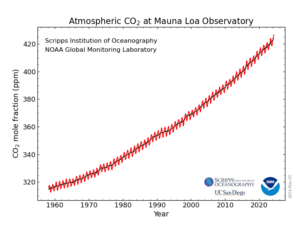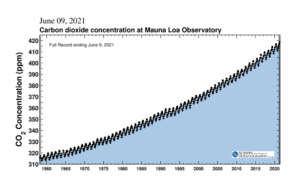 Carbon dioxide levels in the atmosphere reached a new high in 2020 - and this in spite of the COVID-19 world-wide lockdowns. Yikes!
Carbon dioxide levels in the atmosphere reached a new high in 2020 - and this in spite of the COVID-19 world-wide lockdowns. Yikes!
In May 2020 the carbon dioxide levels in our atmosphere reached a peak of 417.1 ppm (parts per million)! The carbon dioxide levels slightly fluctuate daily (on November 30, 2020 they were at 413.81 ppm at the Mauna Loa Observatory). But over the years they have been rising (an average of 2.37 ppm per year in the last decade), and are now at levels not experienced in several million years!
 This is of concern not just because the earth is warming (resulting in more extreme weather), but also what higher and higher carbon dioxide levels might do to our thinking processes. Think of a "stuffy room" where it is harder to think - this can already occur starting at about 600 ppm of CO2, and known to occur at 945 ppm and higher (in rooms with many people in them). While current CO2 levels are below that, we are faced with the possibility that if they keep rising we will get there eventually - and there will be no escape from the "stuffy room" feeling!
This is of concern not just because the earth is warming (resulting in more extreme weather), but also what higher and higher carbon dioxide levels might do to our thinking processes. Think of a "stuffy room" where it is harder to think - this can already occur starting at about 600 ppm of CO2, and known to occur at 945 ppm and higher (in rooms with many people in them). While current CO2 levels are below that, we are faced with the possibility that if they keep rising we will get there eventually - and there will be no escape from the "stuffy room" feeling!
Yes, there is research on this topic - studies suggest that at high levels of carbon dioxide our thinking gets worse. A University of Colorado study reports that a growing body of evidence finds that as CO2 levels increase, there are effects on thinking (cognitive functioning), including decision making, planning, and complex strategic thinking. As carbon dioxide levels rise to 945 ppm and higher, the effects are even more significant, especially with mentally demanding tasks.
There are also physical effects of rising carbon dioxide exposure in humans: increased CO2 in the lungs, in the blood, and in the brain (which is associated with reduced oxygen and brain activity), increased sleepiness and anxiety (both of which harm cognitive function), and acidosis (lowered blood pH - which leads to symptoms such as restlessness and a rise in blood pressure). One study in juvenile rats found "reduced levels of neuroprotective growth factor", which harmed brain development and impaired learning and memory.
What about babies and children? Developing fetuses? The elderly? The sick? All unknown. Also, studies looking at effects are short term, but our future (if not changed) will have us exposed to higher and higher levels of CO2 all the time.
Further information: Scientists from NOAA and Scripps Institution of Oceanography monitor the values at the Mauna Loa Observatory and found that monthly carbon dioxide (CO2) values at Mauna Loa first breached the 400 ppm threshold in 2014. Go look at the graph and click on all the links. Yes, it's scary unless we all make a huge effort to cut global CO2 emissions.
World Meteorological Association: Carbon dioxide levels continue at record levels, despite COVID-19 lockdown
NOTE: The atmosphere is the air and gases in it that surround the earth.
 It shouldn't be a surprise to read that carbon dioxide levels in the atmosphere are surging and accumulating faster than ever. In May, it surged to 427 parts per million (426.90 ppm) - while in 1960 it was about 320 ppm. It's depressing, and it doesn't bode well for our future.
It shouldn't be a surprise to read that carbon dioxide levels in the atmosphere are surging and accumulating faster than ever. In May, it surged to 427 parts per million (426.90 ppm) - while in 1960 it was about 320 ppm. It's depressing, and it doesn't bode well for our future.


 This is of concern not just because the earth is warming (resulting in more extreme weather), but also what higher and higher carbon dioxide levels might do to our thinking processes. Think of a "stuffy room" where it is harder to think - this can already occur starting at about 600 ppm of CO2, and known to occur at 945 ppm and higher (in rooms with many people in them). While current CO2 levels are below that, we are faced with the possibility that if they keep rising we will get there eventually - and there will be no escape from the "stuffy room" feeling!
This is of concern not just because the earth is warming (resulting in more extreme weather), but also what higher and higher carbon dioxide levels might do to our thinking processes. Think of a "stuffy room" where it is harder to think - this can already occur starting at about 600 ppm of CO2, and known to occur at 945 ppm and higher (in rooms with many people in them). While current CO2 levels are below that, we are faced with the possibility that if they keep rising we will get there eventually - and there will be no escape from the "stuffy room" feeling! The possibility that rising carbon dioxide levels could eventually result in harmful effects on people's thinking (cognition) is scary. Currently levels are above 400 ppm and rising steadily each year. The Intergovernmental Panel on Climate Change predicts that outdoor CO2 levels could climb to 930 ppm by 2100, which means urban and indoor levels would be even higher.
The possibility that rising carbon dioxide levels could eventually result in harmful effects on people's thinking (cognition) is scary. Currently levels are above 400 ppm and rising steadily each year. The Intergovernmental Panel on Climate Change predicts that outdoor CO2 levels could climb to 930 ppm by 2100, which means urban and indoor levels would be even higher.